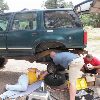Double-clutching is usually reserved for those driving trucks or high performance racing cars, but anyone with a manual transmission can perform this simple feat.
For most manual transmission drivers, the act of shifting gears is a straightforward one. First the clutch is depressed, then the shifter is thrown into the next gear, and finally the clutch is released putting the car back into gear. All of this is usually done without thinking, at least after some practice.
But double clutching adds a third step into the mix. The shifter, rather than going straight to the next gear, makes a stop in neutral and then the clutch is released. This is to allow the engine to slow down (or with a tap on the gas, speed up when downshifting) so the transition into the next gear is much more smooth. The driver then depresses the clutch again and completes the shift into the target gear, and finally the clutch is released again, putting the car back into gear. It only takes a split second for the engine speed to match the speed of the gears, so the entire action is done very quickly as a fluid sequence of events.
Most modern cars, however, are equipped with devices called synchronizers that help to synchronize the speed of the gearbox with that of the engine. This effectively eliminates the need for double clutching. Some large trucks on the other hand have so many gears that synchronizers are inefficient, while race cars can squeeze out more power without them, making double clutching a fact of life.
There are times, however, that a normal car driver may want to make use of double clutching. Many manual transmission drivers realize the advantages of downshifting in slippery conditions. Rather than brake and skid, a car with a manual transmission can make use of the engine to slow down - thereby eliminating the possibility of a skid. But even with synchronizers, a driver trying to shift from fifth gear into second could have some trouble. In this case, double clutching by pausing in neutral and giving the engine a little gas to match speeds of the engine and gearbox, can allow such a drastic shift.
Some driving purists maintain that it's still the proper way to shift, and makes for a much smoother ride. It eliminates some of the jumpiness sometimes felt in a manual transmission car, and it decreases the stress on the gearbox. In any case, double clutching a skill worth having in emergency downshift situations, and not very difficult to learn.










